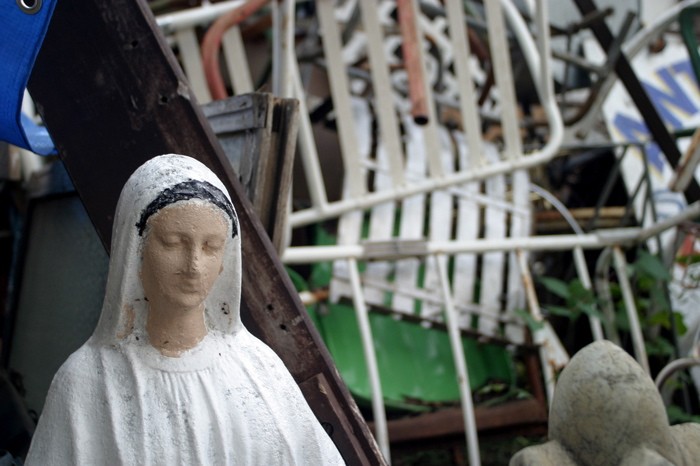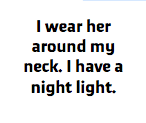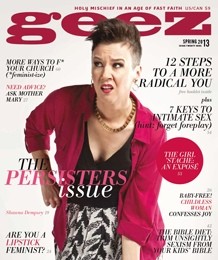Material girl

Credit: Marc Brubaker, http://www.flickr.com/photos/98908999@N00/66099987
My first Mary came from my Irish Catholic Nana.
I would take the Holy Mother with her plastic green benevolence into the back closet and she would glow in the dark. Materially, she is most of my inheritance.
When I was in my teens, I defected from Rome into a hot, torrid affair with Evangelicalism. Catholics worship Mary. I was confused. None of the Catholics I knew did. But you pray to her. Of course. Because she can hear me. Because she intercedes for me. I ask my mother and grandmother to pray for me, too.
The Evangelicals taught me to recite the Bible. The first thing I memorized was Mary’s Song. “He has been mindful of the humble state of his servant; from now on all generations will call me
blessed . . . he has lifted up the lowly, he has filled the hungry with good things and sent the rich away empty.” Exactly.
I read Walking on Water and Madeleine L’Engle said that Mary was like an artist, gestating divinity. The artist has to agree to the work, has to find ways to submit and let the work become what it will without presupposition, with immense patience. The more I wrote, the more I knew this was true. Creation – matter – comes to fullness not through force but through tending.
These days, a shelf in my office is devoted to Mary’s image. I rescue her statuettes from thrift stores and garage sales, from friends who’ve gone off her. She’s Korean, Dutch, Mexican, wooden, ceramic. I wear her around my neck. I have a night light. I want to keep her close to me.
I like Mary’s relationship with God. When the angel tells Mary that he has good news, Mary is troubled. Sensible gal. Any thinking person knows that God’s good is a razor-edged Möbius strip of grace and sacrifice indivisibly interconnected. There is intimacy in finding God suspect, a maturity in relationship when you can question the methods of the Lord Almighty. Mary’s troubled response steps away from self-effacement and the placation of power and into the vulnerable discussions of friendship. Sometimes I imagine scenarios where God is Mary’s weirdest, dearest friend – someone like Glenn Gould – and I am Mary. We sneak off together to smoke cigarettes behind the school. I think God is on Mary’s side, and it makes me like him more.
 In spite of the statues, my vestiges of Catholicism are not orthodox. There’s the lurking aura of Mary’s eternal virginity, but it’s hard for me to credit. What of Mary and sex? I email my BFF Mari the Theologian and ask if being “overshadowed” has any semblance to fun. Mari says I am unoriginal and probably not. Human-divine intercourse has fraught power dynamics and doesn’t do much to fulfill Old Testament prophecies of miraculous virginal birth. Drat.
In spite of the statues, my vestiges of Catholicism are not orthodox. There’s the lurking aura of Mary’s eternal virginity, but it’s hard for me to credit. What of Mary and sex? I email my BFF Mari the Theologian and ask if being “overshadowed” has any semblance to fun. Mari says I am unoriginal and probably not. Human-divine intercourse has fraught power dynamics and doesn’t do much to fulfill Old Testament prophecies of miraculous virginal birth. Drat.
But Mary’s body is everywhere for me. Baby-making means women and women means body. The thing, ultimately, we are describing with our sex (if not gender) categories is a substantial difference in male and female bodies. To make a fully human baby of natural birth, God needed to engage a womb. The material stuff of Mary’s body is core to the story. Why would God bother with the mess of birth at all if he didn’t want the whole of fleshly collaboration? While there’s a candy shop of reasons to reject the idea that women are saved through child-bearing, I see bodily honour in Mary’s role. The all-sufficient (frequently masculinized, born male) God starts his earth-life story by reminding us of the integral work of female bodies, of each person’s indebtedness to a woman’s nurture.
Why am I so hung up on Mary? Because, in the end, Jesus is a boy. And I’m keen on Jesus, but the mental highland fling around how he is fully female as I am fully female gives me cramps. He didn’t walk around in this vagina-body, this body that disrupts me monthly with its physicality, that is more easily beaten and raped, that renders suspect my sexuality, my intelligence, my judgment and my authority. So I nestle into Mother Mary’s arms not because she’s God but because she gets me. We’re both contained in that important flesh that ties us into sexual birth and casts our lot with the oppressed because the guys still, still get most of the good stuff. When I can’t remember what I’m doing here, I ask Mary. She’s troubled and singing at the same time.
Shannon Marie Blake is the daughter of Linda Mary, the granddaughter of Rita and the great niece of Madie and Madge. If you’re getting rid of a Mary statue, she wants it.



Sorry, comments are closed.